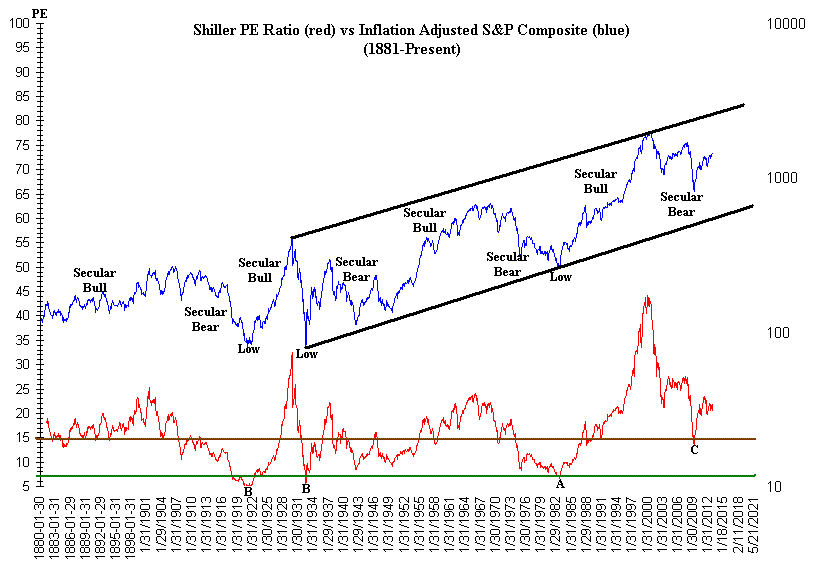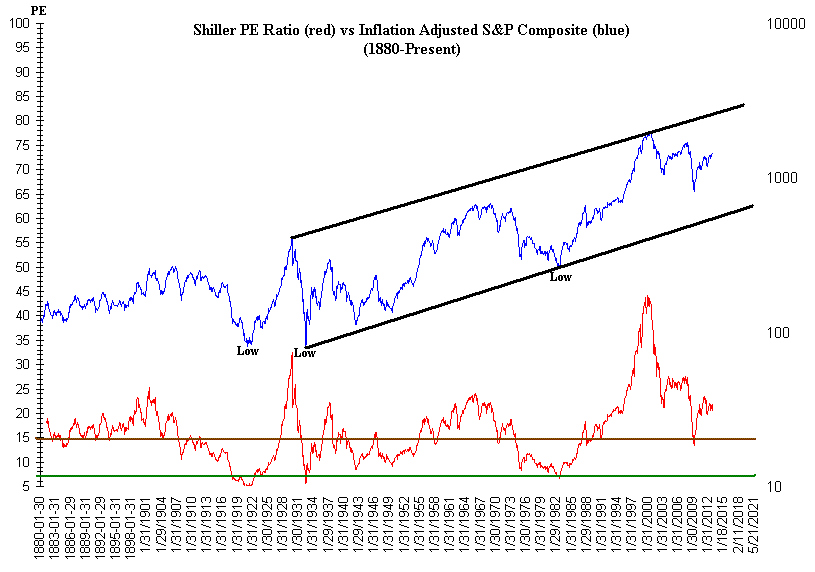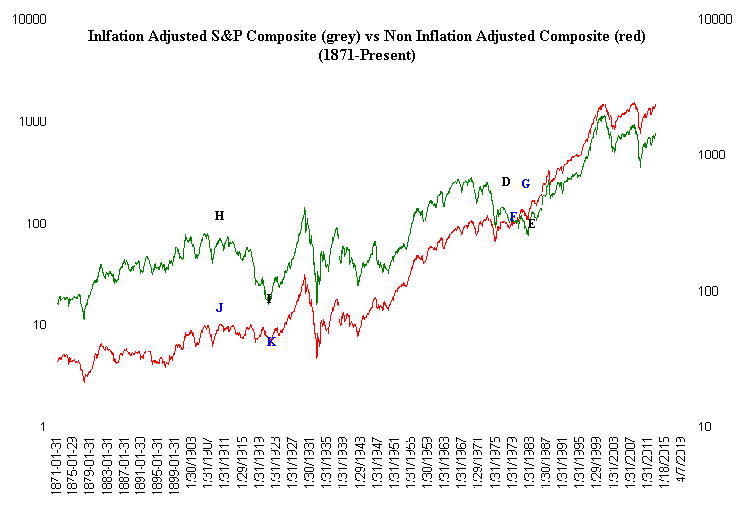|
(12/1/12)
Well here we are with only 30 Days to go until the end of the
year. I haven't talked about Shiller's PE Ratio in awhile so let's take a
look at the chart which goes all the way back to the late 1880's involving the
Inflation Adjusted S&P Composite. The historical Average PE Ratio has
been around 15 as denoted by the brown line. Overall major Bear Market
Bottoms in the past haven't occurred in the Inflation Adjusted S&P Composite
until the PE Ratio has dropped below the "7" level as denoted by the
green line. The most recent event was back in the early 1980's (point A)
followed by two others in the early 1930's and early 1920's (points B).
Meanwhile notice back in March of 2009 when the S&P Composite bottomed the
PE Ratio dropped just below the long term mean (point C) so it didn't reach a
level that has signaled major Bear Market Lows in the past. Thus one
can conclude that either Shiller's PE Ratio will be wrong this time around or
the Inflation Adjusted S&P Composite hasn't made a major Bear Market
Low.

Another thing to notice is the long term upward channel in the
Inflation Adjusted S&P Composite as denoted by the black lines. As you
can see the bottom of the upward channel connects the early 1930's low with the
early 1980's low while the top of the upward channel coincides with the late
1920's high and late 1990's high. My guess would be if Shiller's PE Ratio
is going to end up being right, and eventually drop below the "7"
level, then the Inflation Adjusted S&P Composite will come close to
retesting the bottom of its longer term upward channel at some point in the
future.

The last thing to consider is that when periods of high
inflation occur this can have a dramatic affect on what a normal chart looks
like versus an Inflation Adjusted one. If we overlay the Inflation
Adjusted S&P Composite (green) with the typical non Inflation Adjusted
S&P Composite (red) one can see significant differences at times. For
example from the late 1970's through the early 1980's the Inflation Adjusted
S&P Composite trended lower (points D to E) while the non Inflation Adjusted
S&P Composite actually moved higher (points F to G). A similar
pattern also occurred back in the early 1900's as the Inflation Adjusted S&P
Composite made substantially lower Lows (points H to I) while the Non Inflation
Adjusted S&P Composite traded generally sideways for several years (points J
to K). Thus it's entirely possible in the future the Inflation
Adjusted Composite could drop back below the March 2009 low while the Non
Inflation Adjusted S&P Composite does not.

Signup for a "Free 4 Week Trial Membership" or save
up to 50% on a Premium Membership and you will have access to the following
products.
1. "ETF Daily Buy and Short Signals"
which can be used to trade the DIA's, QQQQ's and SPY's.
2. "401K/Thrift Savings Plan (TSP) Timing
Service" which can be used to help improve your return in your 401k/TSP
Account.
3. The "End of Month Strategy".
This Strategy focuses on the typical End of Month markup by the Institutional
Money.
4. "Stocks to Buy List" which can be
used with either our Short Term Strategy or Long Term Strategy.
Our Winter Membership Special for
new Members is shown below
which are 50% Off our normal Monthly Rate of $39.95
|
Membership Plans
|
Initial 50% Off
Introductory Rate
|
|
30 Day Trial Membership
|
FREE |
| Monthly Membership |
$19.95 |
| 6 Month Membership |
$119.95 |
All Trial and Regular
Memberships are on a renewal basis so please email
us to cancel your Membership before it
renews as they "aren't refundable".
After the Introductory Period expires Memberships
will automatically renew at our normal Monthly Discounted Rate of $21.95.
Send this Free Newsletter to a Friend or Relative
Amateur Investors
|



